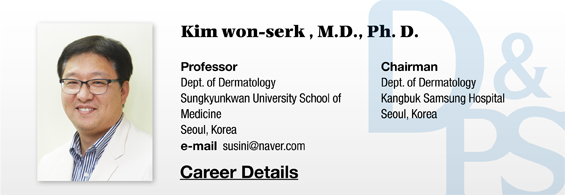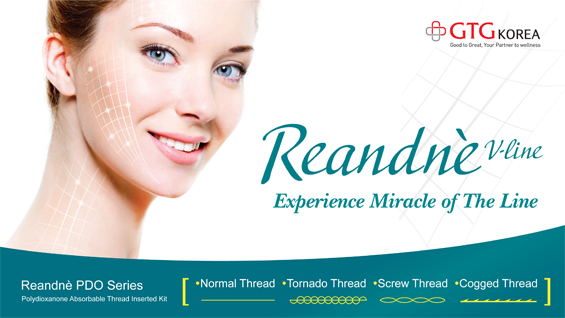Scars are treated by various methods including surgery, laser, drugs or external preparations. Recently, laser treatment becomes popular. Before laser scar treatment, general understanding about scars are absolutely necessary. This series attempts to deliver general information about scars in addition to the definition and pathological analysis of scars. The author is Professor Kim Won-serk at the Department of Dermatology of Kangbuk Samsung Hospital, Sungkyunkwan University. Prof. Kim is actively participating in clinical and academic activities of various fields including dermatology for scar treatment.
1. Definition of scar
Scar is considered as a wrong process of wound healing, which occurs mainly in human and some mammals. Scars are visibly distinct from the surrounding skin by their contour, color and texture and may accompany volume changes, such as in case of atrophy and protrusion. A scar, in a broad sense, includes depressing scar made by acne or trauma, scars accompanying difference only in the color or texture as stretch marks, hypertrophic scar made by protuberance of postoperative suture site or burned site, and keloid which grows continuous like a tumor.
![[Figure 1. Classification of scar]](http://idnps.com/media/Definition-and-Pathological-Study-of-Scars1수정2.jpg)
[Figure 1. Classification of scar]
2. Epidemiological study of scars
1) Keloid: Keloid is known to develop only in humans, but there have been reports of keloid cases in some mammals, including horse, cow, dog, etc. Keloid is most frequent in black people, followed by Asians and white people. The incidence is not different between men and women, and occurs often in younger people. Postmenopausal reduction of lesions has been observed in women.
2) Hypertrophic scar: Accurate incidence is not known, but hypertrophic scar is generally more common than keloids and are mostly recovered spontaneously unlike keloids. As with keloids, hypertrophic scar is frequent in the order of black people, Asians and then white people.
![[Figure 2. Clinical patterns of various scars (keloid/mature scare/atrophic scar/immature scare/hypertrophic scar)]](http://idnps.com/media/Definition-and-Pathological-Study-of-Scars2수정.jpg)
[Figure 2. Clinical patterns of various scars (keloid/mature scare/atrophic scar/immature scare/hypertrophic scar)]
3. Causes of scarring
1) Genetic: Generic factors are considered to be involved mostly with keloids. Genetic factors, such as HLA-B14 and 21, have been studied for their involvement.
2) Trauma: A variety of skin stimulus, including surgery, injection, piercing and burn, may be important causes of scarring.
3) Surface tension: In addition to natural surface tension arising from skin defect, difference in body parts also makes some parts more easily affected than other body parts. For example, scars or keloids are bigger and more frequent at sites with major muscle movements (arms and legs) and sites where breathing occurs (front chest).
4) Hormonal effect: Considering the fact that scarring occurs less frequently before puberty and after menopause, it is suspected that sex hormone might have some association with scarring, although the exact association has not been studied a lot.
5) Immunologic cause: Immunology is not considered as an important cause of scarring, but there have been reports that higher serum level of immunoglobulin E was associated with higher frequency of scarring and that allergic people are more likely to develop keloids.
6) Melanin pigment cells: This hypothesis comes from frequent scarring in black people and less frequent scarring in areas without melanin pigment cells.
7) Association of collagen diseases: Patients with a congenital abnormality in collagen metabolism may have excess or lack of scarring.
[Ad. ▶Reandnè Thread Series - Manufacturer: GTG KOREA(www.gtgkorea.com)]
4. Pathological study of scars
1) Scars are mostly confined to the dermis but may extend to the subcutaneous layer in rare cases. The most significant histopathological characteristic of a scar, compared to normal tissues, is the absence of skin appendages (hair and glands)
2) Pathological differences may be observed between an early lesion and an advanced lesion; early lesions show infiltration of inflammatory cells, vasodilation and vascularization, while advanced scars show reduced cell density, deposition of firm and thick collagens, and loss of blood vessels. These pathological features well matched with red color of early scars and white color of mature scars.
3) Scar tissues have thick epidermis and flattening of epidermal ridge.
4) Collagens in scar tissues have increased collagen synthesis than in normal dermis; among others type 1 and type 3 collagens are increased, while type 4 and type 5 are decreased. It has been reported that type 1 collagen increases by 95% in keloids.

5) In the course of wound healing, the most important growth factors for collagen synthesis and contraction in fibroblast are TGF-beta and PDGF, which are increased in scar tissues.
6) Hypoxic condition within tissues is thought as an important triggering factor of scarring. This might be associated with frequent vascular occlusion in scar tissues.
7) Accumulation of immunoglobulin G, A and M is observed often in scar tissues, and there have been reports of autoimmune anti-fibroblast antibodies detected in keloids.
8) A lot of mast cells are detected in scar tissues and, as mentioned earlier, keloid patients often have allergic symptoms. Mast cells distributed between collagen fibers stimulate immunoglobulin E and releases a large number of growth factors, histamine and serotonin, which affects the synthesis of components in the dermis.
![[Figure 3. Pathological finding of a keloid]](http://idnps.com/media/Definition-and-Pathological-Study-of-Scars41.jpg)
[Figure 3. Pathological finding of a keloid]
![[Figure 4. Pathological finding of a hypertrophic scar]](http://idnps.com/media/Definition-and-Pathological-Study-of-Scars4.jpg)
[Figure 4. Pathological finding of a hypertrophic scar]
References
1. Berman B, Zell D. The Medical Treatment of Scarring, In: Arndt KA, editors. Scar Revision. 1st ED. Philadelphia: Elsevier Saunders, 2006:17-43
2. Decker RH, Wilson LD. Effect of Radiation on Wound Healing and the Treatment of Scarring, In: Arndt KA, editors. Scar Revision. 1st ED. Philadelphia: Elsevier Saunders, 2006:89-103
3. Al-Attar A, Mess S, Thomassen JM, Kauffman CL, Davision SP. Keloid Pathogenesis and Treatment. Plast Reconstr Surg 2006; 117:286-300
- To be continued-
▶ Next Artlcle : #2. Recent Trend of Scar Treatment





















